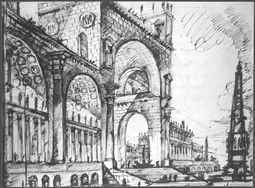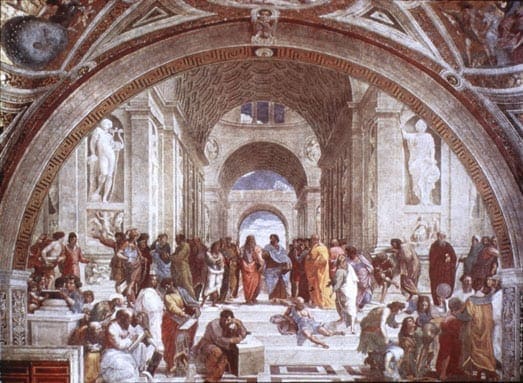
Perspective Sketch by PiranesiPerspective drawing has been on a wild ride for the last 30 years. Illustrators who work in perspective on a daily basis have had their world rocked over this time period....and most of it has been good. Starting in the early 1980's computer programs were beginning to pop up that would be able to figure out the perspective for you--and that, as Humphrey Bogart would say, was the "beginning of a long and beautiful relationship" between the illustrator and his computer. So why am I showing you a picture from the 1780's by Piranesi when I am talking about the 1980's? Because not a whole lot changed for a long time in the perspective world before computers arrived on the scene. For centuries, creating a perspective drawing meant laboriously following a time-honored procedure of plan projection, picture planes, station points, and vanishing points all hand-drawn on a flat piece of paper on a drawing board. It was, for those of us very familiar with the procedure, a "labor of love", a necessity in order to provide an accurate and believable perspective of a building, a landscape--whatever the subject of the drawing happened to be....2-Point Perspective Diagram
This simple diagram shows the basics of perspective drawing as we know it. Lines that are parallel converge toward a common “vanishing point”, either to the left or the right….One can measure heights by scaling them at a particular point (at the picture plane) and then projecting them forward or backward in perspective to show the heights correctly–or, as they would appear in perspective context. But we don’t need to know all that now, because the computer does all the figuring for us, right? It wouldn’t matter whether we could tell a station point from a vanishing point, or even knew what a picture plane was….right? Think again….
that are available are fantastic, especially when you want to change a view angle or get multiple views of a subject–you can even do “fly-overs” and animation, allowing one to virtually “walk through” a building before it is built. I happen to use FormZ, by AutodesSys, and I like it best for its ability to fine-tune a perspective layout view–being able to get exactly the view you want by moving the station point location, the cone of vision, and making all the verticals vertical, even if your view angle would not typically allow this–it’s fantastic! But let me state clearly: a good fundamental understanding of the perspective method and how it works is essential to good illustration work….Having a perspective program on your computer does not mean you have mastered the art of perpective presentation. As in any other artistic endeavor, it is the hand that guides the tool that makes all the difference….Before and after the computer, the artist’s judgment of what creates a good view angle, and the knowledge of how to best manipulate the tools is the key….You need to see it in your “mind’s eye” before you even sit down at the computer or the drawing board….The rest of the process only confirms what you already knew in the beginning.
…

Recent Comments